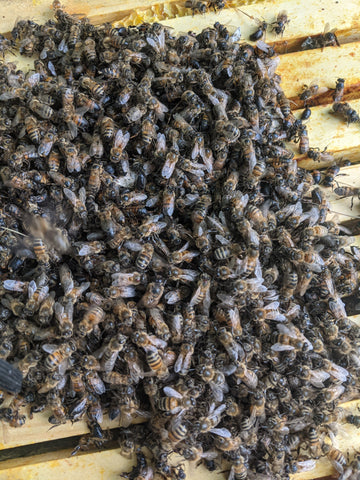
Avital's started as a beekeeping business, and that hasn't entirely changed. True, we don't make candles, but we still keep bees and use the things our bees (and other New York State bees) make in our skincare and haircare. Bees are still very much a part of what we do.
Last weekend, I got a call about a swarm of bees on a lamp pole near my house. I posted some pictures on social media, and questions came in. So here we go!
Beekeepers love catching swarms--it's literally a free colony of bees for the catching. But first, what IS a swarm?
Think of a colony of bees as a single organism. How does one colony become two? By swarming.
In late spring, the queen and about half the bees may leave the hive to find a new home. The queen leaves behind a few queen cells (developing queens) to replace herself. What was one colony will become two--or at least have a chance to become two.
When the swarm first leaves, they fly off together and then cluster, often on a branch. But sometimes they land on a lamp post, car, curb, or other inconvenient flat space. For a beekeeper, the ideal is a relatively thin branch about 5 feet off the group. Snap the branch with the ball of bees on it, put them in a box, and go home.
If a beekeeper doesn't come along, that ball of bees will hang out for a few hours up to a couple of days, waiting for their scouts to find a new home that they all agree on. The new home is sometimes a lucky beekeeper's bait hive or a hollow tree. But I've also rescued colonies from kettle grills, compost bins, and memorably, from the ceiling of a porch.
Sometimes the scouts can't find anything decent and the poor bees are stranded, even occasionally trying to create an open-air nest. That never works in this part of the world.
So swarming is dicey for the bees. Like all reproduction in nature, it's a risk. If a beekeeper like me comes along, their odds are much better. In this case, the bees were on a lamp post, near the base. Apparently, people walked by on the adjacent sidewalk without noticing them, probably because they were near the base and blended in. Good thing, too, because I've seen poor swarms tormented by people knocking them down, spraying them, or otherwise harassing them. It should go without saying: please don't do that. Call a beekeeper instead.
I'm not sure how long this little swarm had been on the post. They had deposited bits of wax on it, though, as if contemplating staying, so it may have been a couple of days. I would like to point out that I had a perfectly good bait hive set up two blocks away. I wish they had just moved in and saved us all the trouble, but...anyway.

In this case, I tried to sweep them into a box that had a couple of frames of comb, plus a little spritz of attractant. Sometimes that works, especially if you brush the queen in. The workers will follow her anywhere. In this case, I didn't manage to sweep her in, apparently, because they all returned to the light pole.
Next, I pulled out the bee vac and a beekeeper's jacket.
Swarms tend to be gentle. They don't have any honey or brood to protect and they really just want to find new digs. So often, I'll capture a swarm in street clothes, as above. But when I realized it was going to require a bee vac, I put on my jacket. Lots of bees would be flying and in that case, it's good to keep them away from your hair and face. Notice, though, that I never put on gloves. And I'm wearing sandals. And no, I didn't get stung (that questions always gets asked!).
The bee vac is a repurposed shop vac with an inside mesh container to hold the

bees. They get sucked gently into the container so that I can take them away and rehome them. They are pretty sturdy, and this process doesn't hurt them.
Once they were in the bee vac's cage, I unplugged everything and took them home. I already had a bait hive set up, so there was no problem lifting the lid and putting them inside.
As I looked at the bees clustered on top of the frames, I suddently saw the queen walking among them. Alas, she disappeared before I could get my phone out and take a picture. But it was good to know that she was there and in good health. I'll leave them alone for a week or so to get settled in, and then I'll check on them to make sure all's well.


Hi Diane,
Honey bees won’t usually come after you, so I suspect they are hornets or wasps. Is the nest inside the tree, or a paper wasp type ball hanging from a branch?
Hi Leslie,
I discovered bees in an evergreen tree (not sure exactly what it is, only about 6’ tall) while mowing the lawn. The first time the got me; it was the second time mowing around this tree that I figured out where they were coming from. Do you think they are honey bees? How do I get rid of bees in tree?
I look forward to hearing from you.
Diane